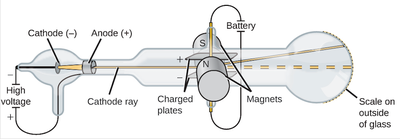
371 Google Scholar ‘The passage of electricity through gases’, British Association Report, ( 1889), p. 317, 495 CrossRef Google Scholar ‘Experiments on the discharge of electricity through gases’, Proceedings of the Royal Society, ( 1887), 42, p. Schuster, A., ‘ Experiments on the discharge of electricity through gases: a sketch of a theory’ (Royal Society Bakerian Lecture), Proceedings of the Royal Society, ( 1884), 37, pp. At the relatively high pressures of Thomson's experiments, cathode rays were not a significant phenomenon, but they probably were in Schuster's experiments. Neither quotes figures for the pressures they were working at, but Schuster appears to have expended more time in evacuating his apparatus.

is of one and the same kind this matter being the substance from which all the chemical elements are built up.34 This difference between Schuster and Thomson was probably largely due to the conditions under which they performed their experiments. Homson boldly announced the hypothesis that "we have in the cathode rays matter in a new state, a state in which the subdivision of matter is carried very much further than in the ordinary gaseous state: a state in which all matter. "We have in the cathode rays matter in a new state." Measurement of the value of the charge ( e) and confirmed this The proof was far from conclusive.īut experiments by others in the next two years yielded an independent That if cathode rays were particles they had to have a mass very much Experimenting on how cathode rays penetrate gases, he showed (as compared with a charged atom), or else they were amazingly light relativeĬhoice between these possibilities was settled by Philipp Either the cathode rays carried an enormous charge To be far smaller than that of a charged hydrogen atom-more than one Just as Emil Wiechert had reportedĮarlier that year, the mass-to-charge ratio for cathode rays turned out He collected data using a variety of tubes and using different gases.

From this data he could calculate the ratio of the mass of a particle to its electric charge ( m/ e). Although he couldn't measure directly the mass or the electric charge of such a particle, heĬould measure how much the rays were bent by a magnetic field, and how much energy they carried. Homson's third experiment sought to determine the basic properties of the particles. Homson concluded from these two experiments, "I can see no escape from the conclusion that are charges of negative electricity carried by particles of matter." But, he continued, "What are these particles? are they atoms, or molecules, or matter in a still finer state of subdivision?" To test this idea, he took great pains to extract nearly all of the gas from a tube, and found that now the cathode rays did bend in an electric field after all. Thomson suspected that the traces of gas remaining in the tube were being turned into an electrical conductor by the cathode rays themselves. A charged particle will normally curve as it moves through an electric field, but not if it is surrounded by a conductor (a sheath of copper, for example). Ll attempts had failed when physicists tried to bend cathode rays with an electric field. As Thomson saw it, the negative charge and the cathode rays must somehow be stuck together: you cannot separate the charge from the rays. The electrometer did not register much electric charge if the rays were bent so they would not enter the slit. He found that when the rays entered the slit in the cylinders, the electrometer measured a large amount of negative charge. Thomson wanted to see if, by bending the rays with a magnet, he could separate the charge from the rays. Perrin had found that cathode rays deposited an electric charge. These cylinders were in turnĬonnected to an electrometer, a device for catching and measuring electrical charge. Irst, in a variation of an 1895 experiment by Jean Perrin, Thomson built a cathode ray tube ending in a pair of metal cylinders with a slit in them.

He advanced the idea that cathode rays are really streams of very small pieces of atoms.


 0 kommentar(er)
0 kommentar(er)
